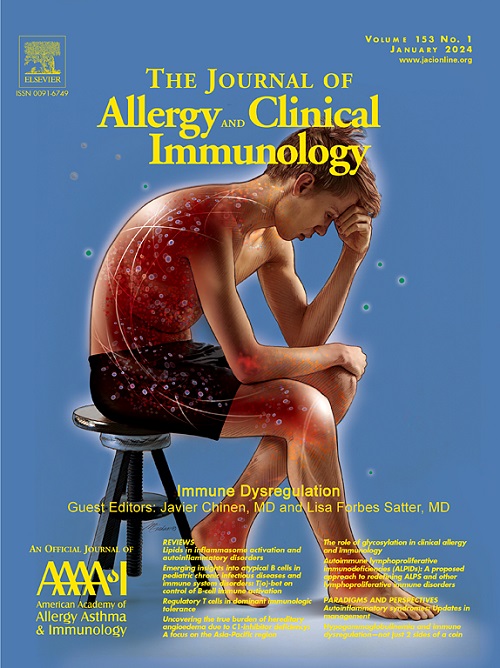Genetic risk for adult obstructive lung function and its early life associations
IF 11.2
1区 医学
Q1 ALLERGY
引用次数: 0
Abstract
Background
Chronic obstructive pulmonary disease may partly originate in early life under influence from prenatal or early postnatal risk factors, including genetic predisposition.
Objectives
We investigated the extent to which the genetic predisposition to adult obstructive lung function manifests already at birth and throughout childhood in terms of impaired lung function, bronchial responsiveness, and asthma-related symptoms.
Methods
We constructed a polygenic risk score (PRS) for adult obstructive lung function (FEV1/forced vital capacity [FVC]) and associated it with neonatal and childhood lung function, bronchial responsiveness, asthma, and respiratory tract infections in the COPSAC (Copenhagen Prospective Studies on Asthma in Childhood) birth cohorts, and with hospitalization for wheeze, asthma, and infections in 114,283 unrelated individuals from the The Lundbeck Foundation Initiative for Integrative Psychiactric Research (iPSYCH) cohort.
Results
The FEV1/FVC PRS was associated with obstructive lung function shortly after birth (eg, neonatal FEV0.5/FVC [β: −0.20; 95% CI: −0.31 to −0.09; P < .0003]), with continued progression into adolescence. A higher PRS was also linked to an increased risk of severe wheeze/asthma episodes (odds ratio: 1.24; 95% CI: 1.19-1.29; P = 1.6 × 10−26) and lower respiratory tract infections (odds ratio: 1.09; 95% CI: 1.06-1.12; P = 3.5 × 10−8) requiring hospitalization, which was evident a few months after birth. In COPSAC2000, there was no evidence of asthma exacerbations mediating the association between FEV1/FVC PRS and lung function by age 18 years.
Conclusions
Genetic predisposition to obstructive lung function was evident shortly after birth in terms of impaired neonatal lung function and increased susceptibility to severe wheeze, asthma, and lower respiratory tract infections. This indicates prenatal life and early childhood as a window of opportunity for improving lung health in adulthood.

成人阻塞性肺功能的遗传风险及其早期生活关联。
背景:慢性阻塞性肺疾病(COPD)可能部分起源于生命早期,受到产前或产后早期风险因素的影响,包括遗传易感性。目的:研究成人阻塞性肺功能的遗传易感性在出生时和整个儿童时期表现为肺功能受损、支气管反应性和哮喘相关症状的程度。方法:我们构建了成人阻塞性肺功能(FEV1/FVC)的多基因风险评分(PRS),并将其与COPSAC出生队列中新生儿和儿童肺功能、支气管反应性、哮喘和呼吸道感染,以及来自IPSYCH队列的114,283名非相关个体的喘息、哮喘和感染住院治疗相关联。结果FEV1/FVC PRS与出生后不久的阻塞性肺功能相关(例如,新生儿FEV0.5/FVC (β: -0.20 [-0.31;-0.09], P < 0.0003)),并持续进展到青春期。较高的PRS还与严重喘息/哮喘发作(OR 1.24 [1.19;1.29], P = 1.6∙10-26)和需要住院治疗的下呼吸道感染(OR 1.09 [1.06-1.12], P = 3.5∙10-8)的风险增加有关,这在出生后几个月就很明显了。在COPSAC2000中,没有证据表明哮喘加重介导18岁时FEV1/FVC PRS与肺功能之间的关联。结论出生后不久,新生儿肺功能受损,严重喘息、哮喘和下呼吸道感染易感性增加,具有明显的阻塞性肺功能遗传易感性。这表明产前生活和幼儿期是改善成年期肺部健康的机会之窗。
本文章由计算机程序翻译,如有差异,请以英文原文为准。
求助全文
约1分钟内获得全文
求助全文
来源期刊
CiteScore
25.90
自引率
7.70%
发文量
1302
审稿时长
38 days
期刊介绍:
The Journal of Allergy and Clinical Immunology is a prestigious publication that features groundbreaking research in the fields of Allergy, Asthma, and Immunology. This influential journal publishes high-impact research papers that explore various topics, including asthma, food allergy, allergic rhinitis, atopic dermatitis, primary immune deficiencies, occupational and environmental allergy, and other allergic and immunologic diseases. The articles not only report on clinical trials and mechanistic studies but also provide insights into novel therapies, underlying mechanisms, and important discoveries that contribute to our understanding of these diseases. By sharing this valuable information, the journal aims to enhance the diagnosis and management of patients in the future.

 求助内容:
求助内容: 应助结果提醒方式:
应助结果提醒方式:


